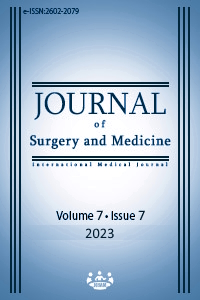Assessment of the risk for cholecystitis when performing laparoscopic cholecystectomy in a retrospective cohort study
Assessment of the risk for cholecystitis
Keywords:
cholecystitis, acute, statinsAbstract
Background/Aim: Acute cholecystitis most often occurs as an acute exacerbation of chronic cholecystitis. In over 90% of patients, the primary factor in the development of acute cholecystitis is the obstruction of the gallbladder or cystic duct with an impacted calculus. In less than 10% of patients, acute cholecystitis can be attributed to other causes: direct trauma to the biliary tract, torsion of the gallbladder, twisting of the vascular loop after surgical procedures on the abdominal organs, and Salmonella typhi infection. The aim of this study is to compare preoperative variables in patients with acute cholecystitis, which are not only important for diagnosis but also have significance in determining the severity of acute cholecystitis in the preoperative period.
Methods: This retrospective systematic research included all clinical cases diagnosed with acute cholecystitis from January 2019 to December 2019, totaling 56 patients at CHC Kosovska Mitrovica. For the study, data from medical records were used for statistical analysis.
Results: A total of 56 patients (mean age 53 years; 26 men and 30 women) were included in this study. Among them, 32 patients (57.15%) had characteristics of simple cholecystitis, while 24 patients (42.85%) had severe cholecystitis. The group with severe cholecystitis consisted of older patients, with equal representation of both sexes, and higher levels of WBC, NE%, PLT, ALT, GGT, total bilirubin, and CRP (P<0.05). Imaging studies showed that the group with severe cholecystitis exhibited significantly more wall distension, particularly in the stratified wall, compared to the group with simple cholecystitis (P<0.05). Severe cholecystitis was associated with statin use (79.2%) and triglyceride values of 1.55 (0.47); both variables showed a statistically significant association with severe cholecystitis (P<0.05).
Conclusion: It is extremely important to skillfully identify patients with simple or severe forms of acute cholecystitis. Possible solutions include organizing campaigns to raise public awareness for faster consultations in cases of acute abdominal pain, establishing universal health coverage (diet), and improving technical platforms.
Downloads
References
Maza JM, Quintero JHR, Santes O, Frasco JLA, Vélez GR, Ramos ESG, et al. Conversion from laparoscopic to open cholecystectomy: Risk factor analysis based on clinical, laboratory, and ultrasound parameters. Rev Gastroenterol Mex (Engl Ed). 2021 Oct-Dec;86(4):363-9. doi: 10.1016/j.rgmxen.2021.08.001 DOI: https://doi.org/10.1016/j.rgmxen.2021.08.001
Micić D, Stanković S, Lalić N, Đukić V, Polovina S. Prognostic value of preoperative neutrophil-to-lymphocyte ratio for prediction of severe cholecystitis. J Med Biochem. 2018 Apr 1;37(2):121-7. doi: 10.1515/jomb-2017-0063 DOI: https://doi.org/10.1515/jomb-2017-0063
Jones MW, Weir CB, Ferguson T. Porcelain gallbladder. StatPearls 2022 Jan. Bookshelf ID: NBK518979
Latenstein CSS, Hannink G, Bilt JDW, Donkervoort SC, Eijsbouts QAJ, Heisterkamp J, et al. A clinical decision tool for selection of patients with symptomatic cholelithiasis for cholecystectomy based on reduction of pain and a pain-free state following surgery. JAMA Surg. 2021 Oct 1;156(10):e213706. doi: 10.1001/jamasurg.2021.3706 DOI: https://doi.org/10.1001/jamasurg.2021.3706
Romano L, Giuliani A, Pessia B, Mattei A, Fiasca F, Tonelli E, et al. The early prediction of mortality in acute cholecystitis: Temperature, neutrophils and multiple organ failure (TNM) score. Eur Rev Med Pharmacol Sci. 2021 Oct;25(20):6339-48. doi: 10.26355/eurrev_202110_27006
Lee SO, Yim SK. Management of acute cholecystitis. Korean J Gastroenterol. 2018 May 25;71(5):264-8. doi: 10.4166/kjg.2018.71.5.264 DOI: https://doi.org/10.4166/kjg.2018.71.5.264
Ciaula AD, Garruti G, Wang DQ, Portincasa P. Cholecystectomy and risk of metabolic syndrome. Eur J Intern Med. 2018 Jul;53:3-11. doi: 10.1016/j.ejim.2018.04.019 DOI: https://doi.org/10.1016/j.ejim.2018.04.019
Burke J, Rattan R, Sedighim Sh, Kim M. A simple risk score to predict Clavien-Dindo grade IV and V complications after non-elective cholecystectomy. J Gastrointest Surg. 2021 Jan;25(1):201-10. doi: 10.1007/s11605-020-04514-9 DOI: https://doi.org/10.1007/s11605-020-04514-9
Fujiwara Sh, Kaino K, Iseya K, Koyamada N. Laparoscopic subtotal cholecystectomy for difficult cases of acute cholecystitis: a simple technique using barbed sutures. Surg Case rep. 2020 Sep 29;6(1):238. doi: 10.1186/s40792-020-01026-1 DOI: https://doi.org/10.1186/s40792-020-01026-1
Wennmacker SZ, Bjimani N, Dijk AH, Hugh TJ, Reuver PhR. Predicting operative difficulty of laparoscopic cholecystectomyin patients with acute biliary presentations. ANZ J Surg. 2019 Nov;89(11):1451-6. doi: 10.1111/ans.15493 DOI: https://doi.org/10.1111/ans.15493
Haal S, Guman MSS, Bruin A, Schouten R, Veen RN, Fockens P, et al. Risk factors for symptomatic gallstone disease and gallstone formation after bariatric surgery. Obes Surg. 2022 Apr;32(4):1270-8. doi: 10.1007/s11695-022-05947-8 DOI: https://doi.org/10.1007/s11695-022-05947-8
Mahmood F, Akingboye A, Malam Y, Thakkar M, Jambulingam P. Complicated acute cholecystitis: The role of C-reactive protein and neutrophil-Lymphocyte ratio as predictive markers of severity. Cureus. 2021 Feb 27;13(2):e13592. doi: 10.7759/cureus.13592. DOI: https://doi.org/10.7759/cureus.13592
Downloads
- 908 996
Published
Issue
Section
How to Cite
License
Copyright (c) 2023 Kasalovic Mladen, Jakovljević Aleksandar , Igrutinović Gojko , Miljković Nikola , Rakić Dalibor , Milentijević Milica
This work is licensed under a Creative Commons Attribution-NonCommercial-NoDerivatives 4.0 International License.
















